REA Diagram for Amazon Travel Club - Accounting Information System
VerifiedAdded on 2023/06/10
|8
|1273
|244
Report
AI Summary
This report presents an REA (Resource, Event, Agent) diagram for Amazon Travel Club's accounting information system. The diagram illustrates the flow of resources (books and cash) through events (sales and cash receipts) managed by various agents (sales representatives, shipping clerks, members, and the system itself). The report details how sales representatives enter orders, shipping clerks pack and ship books, and the system manages inventory and payment processes, including notifications for overdue payments. Additionally, the document includes tables for a relational database, outlining the structure for storing information about books, members, orders, sales representatives, shipping clerks, invoices, and payments. The tables define attributes, data types, and constraints for each entity, providing a foundation for implementing the accounting information system. This student-contributed document is available on Desklib, where students can find similar solved assignments and past papers.
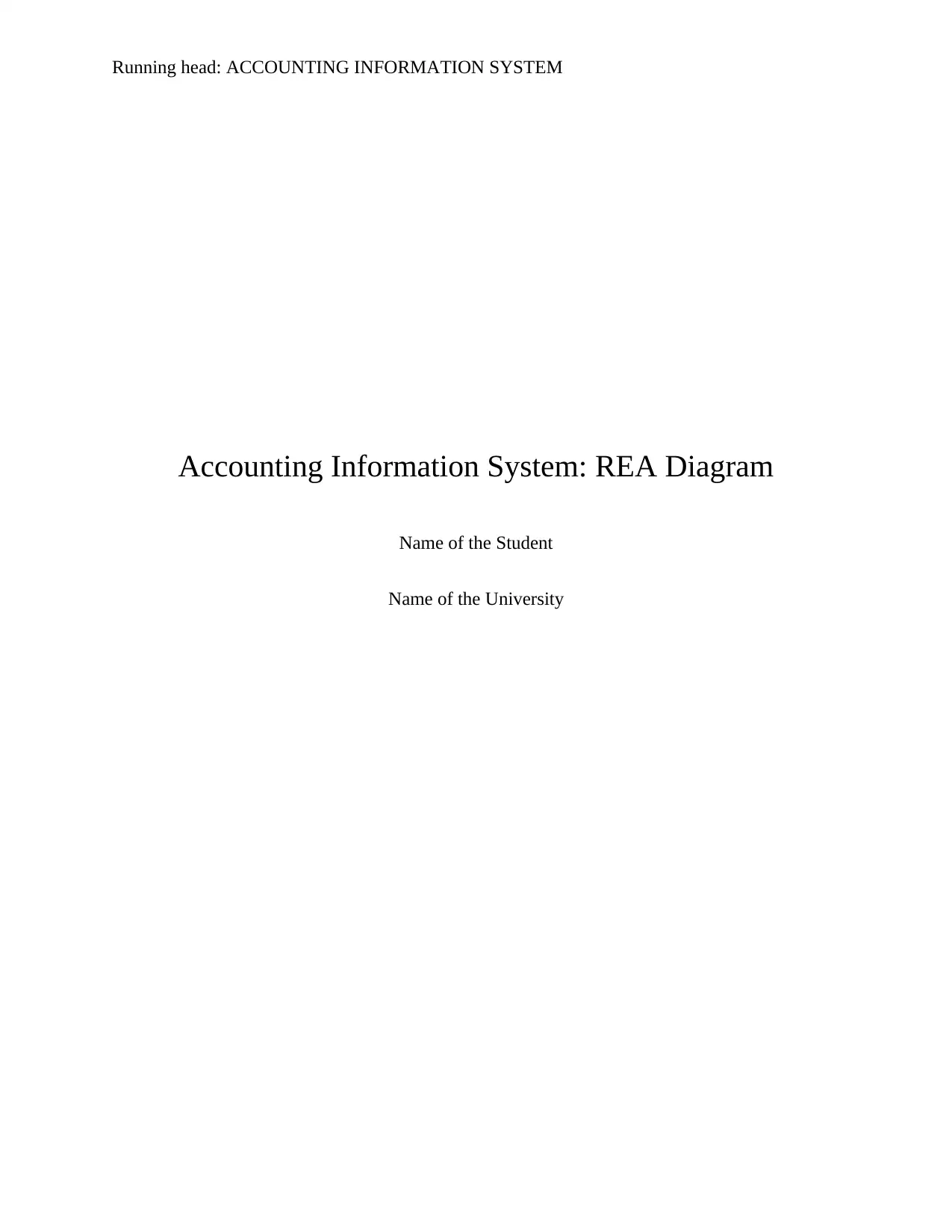
Running head: ACCOUNTING INFORMATION SYSTEM
Accounting Information System: REA Diagram
Name of the Student
Name of the University
Accounting Information System: REA Diagram
Name of the Student
Name of the University
Paraphrase This Document
Need a fresh take? Get an instant paraphrase of this document with our AI Paraphraser
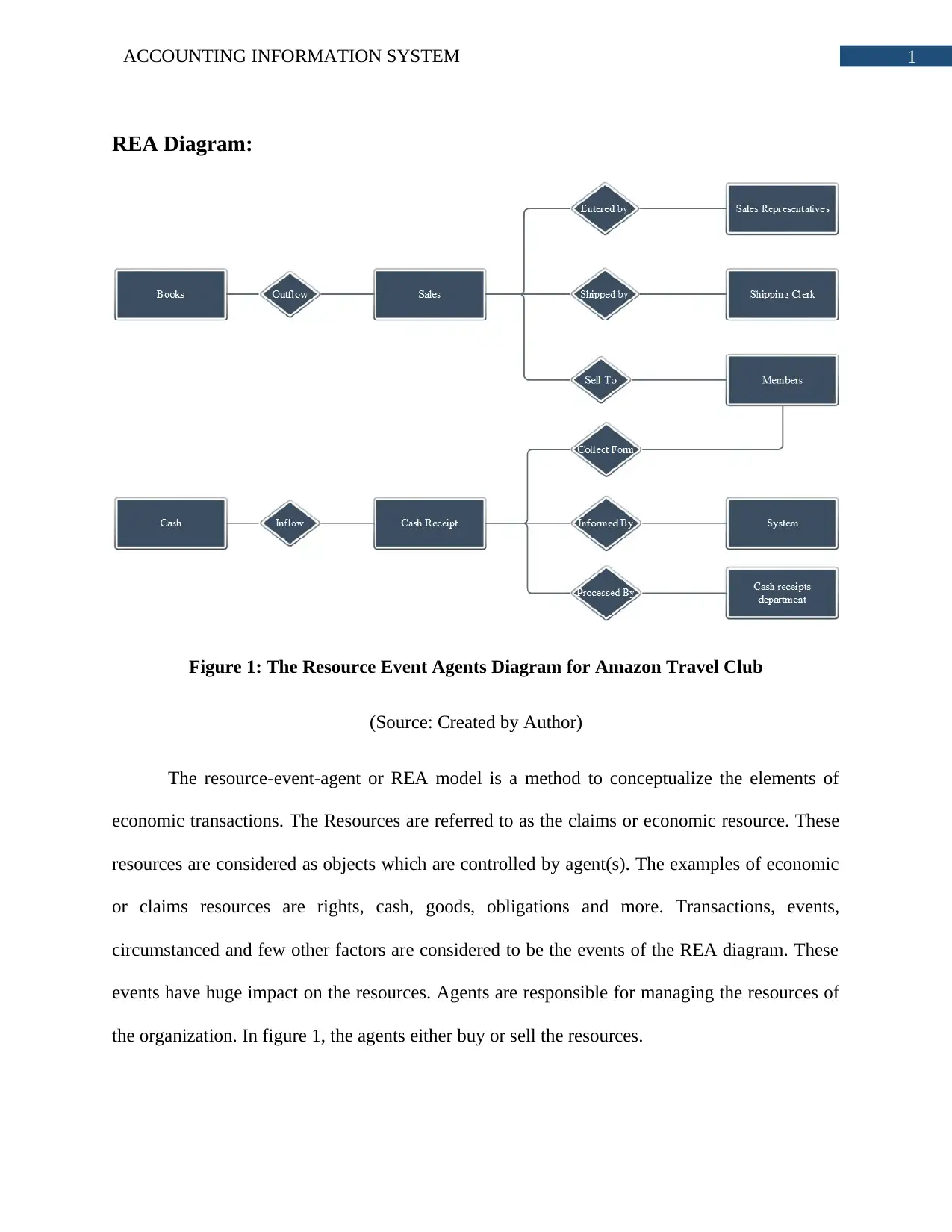
1ACCOUNTING INFORMATION SYSTEM
REA Diagram:
Figure 1: The Resource Event Agents Diagram for Amazon Travel Club
(Source: Created by Author)
The resource-event-agent or REA model is a method to conceptualize the elements of
economic transactions. The Resources are referred to as the claims or economic resource. These
resources are considered as objects which are controlled by agent(s). The examples of economic
or claims resources are rights, cash, goods, obligations and more. Transactions, events,
circumstanced and few other factors are considered to be the events of the REA diagram. These
events have huge impact on the resources. Agents are responsible for managing the resources of
the organization. In figure 1, the agents either buy or sell the resources.
REA Diagram:
Figure 1: The Resource Event Agents Diagram for Amazon Travel Club
(Source: Created by Author)
The resource-event-agent or REA model is a method to conceptualize the elements of
economic transactions. The Resources are referred to as the claims or economic resource. These
resources are considered as objects which are controlled by agent(s). The examples of economic
or claims resources are rights, cash, goods, obligations and more. Transactions, events,
circumstanced and few other factors are considered to be the events of the REA diagram. These
events have huge impact on the resources. Agents are responsible for managing the resources of
the organization. In figure 1, the agents either buy or sell the resources.
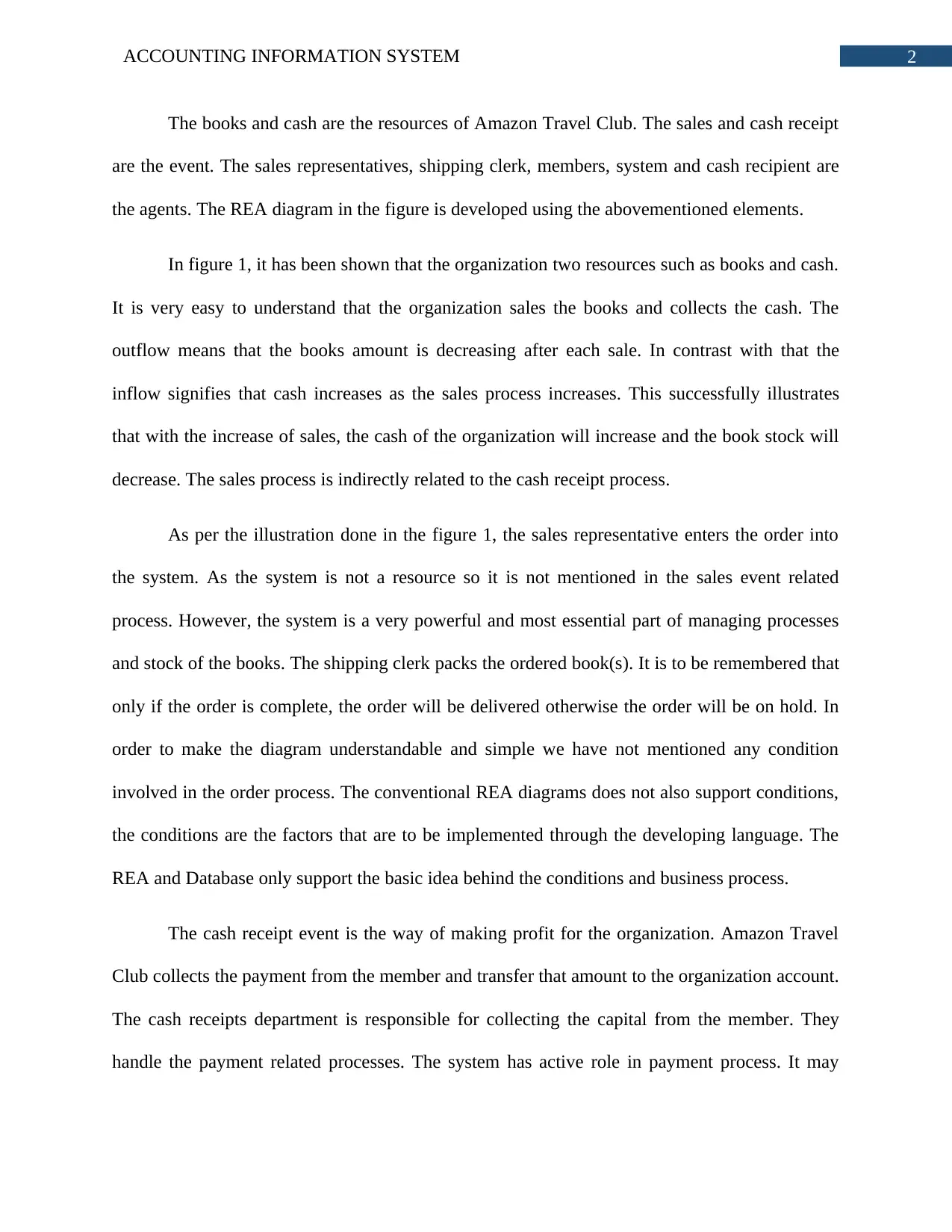
2ACCOUNTING INFORMATION SYSTEM
The books and cash are the resources of Amazon Travel Club. The sales and cash receipt
are the event. The sales representatives, shipping clerk, members, system and cash recipient are
the agents. The REA diagram in the figure is developed using the abovementioned elements.
In figure 1, it has been shown that the organization two resources such as books and cash.
It is very easy to understand that the organization sales the books and collects the cash. The
outflow means that the books amount is decreasing after each sale. In contrast with that the
inflow signifies that cash increases as the sales process increases. This successfully illustrates
that with the increase of sales, the cash of the organization will increase and the book stock will
decrease. The sales process is indirectly related to the cash receipt process.
As per the illustration done in the figure 1, the sales representative enters the order into
the system. As the system is not a resource so it is not mentioned in the sales event related
process. However, the system is a very powerful and most essential part of managing processes
and stock of the books. The shipping clerk packs the ordered book(s). It is to be remembered that
only if the order is complete, the order will be delivered otherwise the order will be on hold. In
order to make the diagram understandable and simple we have not mentioned any condition
involved in the order process. The conventional REA diagrams does not also support conditions,
the conditions are the factors that are to be implemented through the developing language. The
REA and Database only support the basic idea behind the conditions and business process.
The cash receipt event is the way of making profit for the organization. Amazon Travel
Club collects the payment from the member and transfer that amount to the organization account.
The cash receipts department is responsible for collecting the capital from the member. They
handle the payment related processes. The system has active role in payment process. It may
The books and cash are the resources of Amazon Travel Club. The sales and cash receipt
are the event. The sales representatives, shipping clerk, members, system and cash recipient are
the agents. The REA diagram in the figure is developed using the abovementioned elements.
In figure 1, it has been shown that the organization two resources such as books and cash.
It is very easy to understand that the organization sales the books and collects the cash. The
outflow means that the books amount is decreasing after each sale. In contrast with that the
inflow signifies that cash increases as the sales process increases. This successfully illustrates
that with the increase of sales, the cash of the organization will increase and the book stock will
decrease. The sales process is indirectly related to the cash receipt process.
As per the illustration done in the figure 1, the sales representative enters the order into
the system. As the system is not a resource so it is not mentioned in the sales event related
process. However, the system is a very powerful and most essential part of managing processes
and stock of the books. The shipping clerk packs the ordered book(s). It is to be remembered that
only if the order is complete, the order will be delivered otherwise the order will be on hold. In
order to make the diagram understandable and simple we have not mentioned any condition
involved in the order process. The conventional REA diagrams does not also support conditions,
the conditions are the factors that are to be implemented through the developing language. The
REA and Database only support the basic idea behind the conditions and business process.
The cash receipt event is the way of making profit for the organization. Amazon Travel
Club collects the payment from the member and transfer that amount to the organization account.
The cash receipts department is responsible for collecting the capital from the member. They
handle the payment related processes. The system has active role in payment process. It may
⊘ This is a preview!⊘
Do you want full access?
Subscribe today to unlock all pages.

Trusted by 1+ million students worldwide
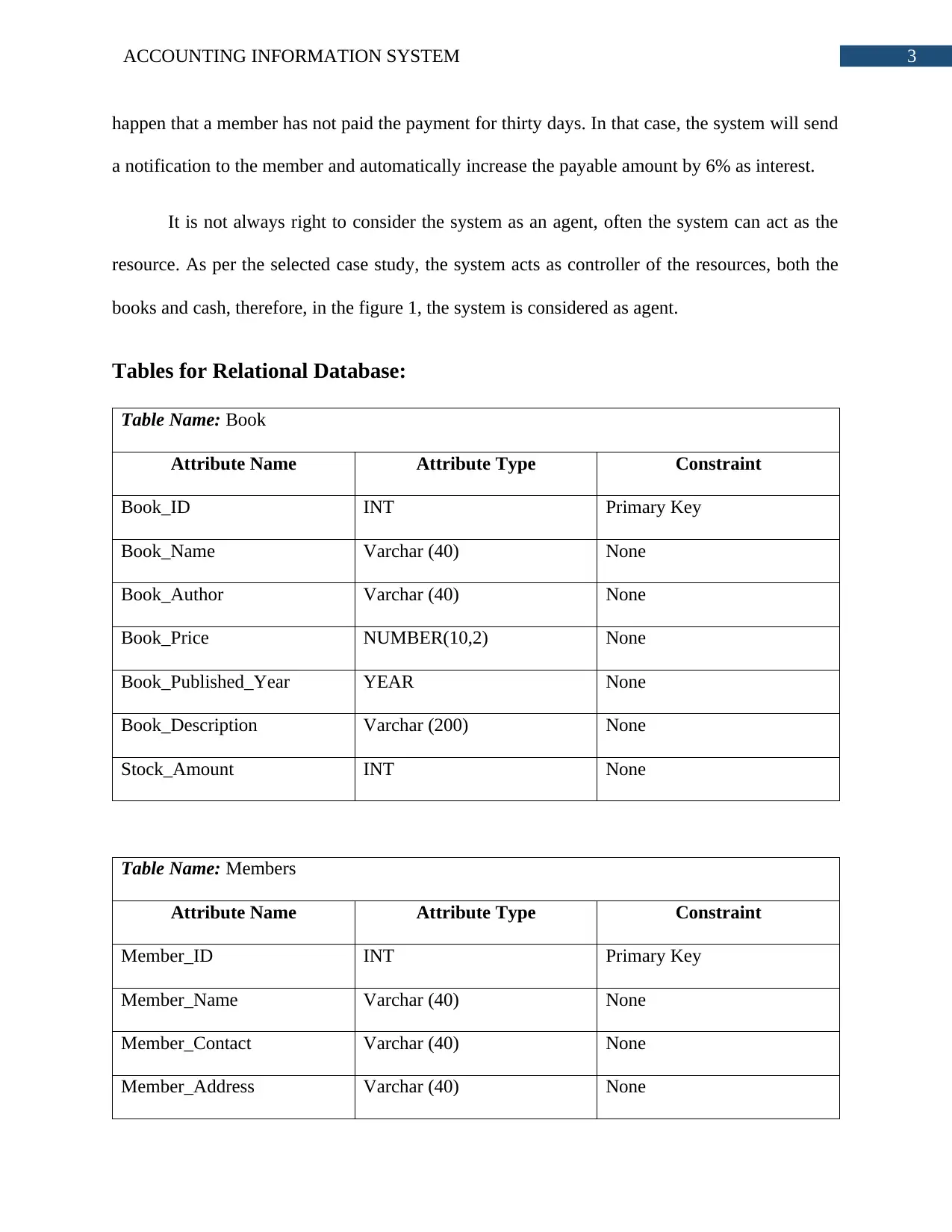
3ACCOUNTING INFORMATION SYSTEM
happen that a member has not paid the payment for thirty days. In that case, the system will send
a notification to the member and automatically increase the payable amount by 6% as interest.
It is not always right to consider the system as an agent, often the system can act as the
resource. As per the selected case study, the system acts as controller of the resources, both the
books and cash, therefore, in the figure 1, the system is considered as agent.
Tables for Relational Database:
Table Name: Book
Attribute Name Attribute Type Constraint
Book_ID INT Primary Key
Book_Name Varchar (40) None
Book_Author Varchar (40) None
Book_Price NUMBER(10,2) None
Book_Published_Year YEAR None
Book_Description Varchar (200) None
Stock_Amount INT None
Table Name: Members
Attribute Name Attribute Type Constraint
Member_ID INT Primary Key
Member_Name Varchar (40) None
Member_Contact Varchar (40) None
Member_Address Varchar (40) None
happen that a member has not paid the payment for thirty days. In that case, the system will send
a notification to the member and automatically increase the payable amount by 6% as interest.
It is not always right to consider the system as an agent, often the system can act as the
resource. As per the selected case study, the system acts as controller of the resources, both the
books and cash, therefore, in the figure 1, the system is considered as agent.
Tables for Relational Database:
Table Name: Book
Attribute Name Attribute Type Constraint
Book_ID INT Primary Key
Book_Name Varchar (40) None
Book_Author Varchar (40) None
Book_Price NUMBER(10,2) None
Book_Published_Year YEAR None
Book_Description Varchar (200) None
Stock_Amount INT None
Table Name: Members
Attribute Name Attribute Type Constraint
Member_ID INT Primary Key
Member_Name Varchar (40) None
Member_Contact Varchar (40) None
Member_Address Varchar (40) None
Paraphrase This Document
Need a fresh take? Get an instant paraphrase of this document with our AI Paraphraser
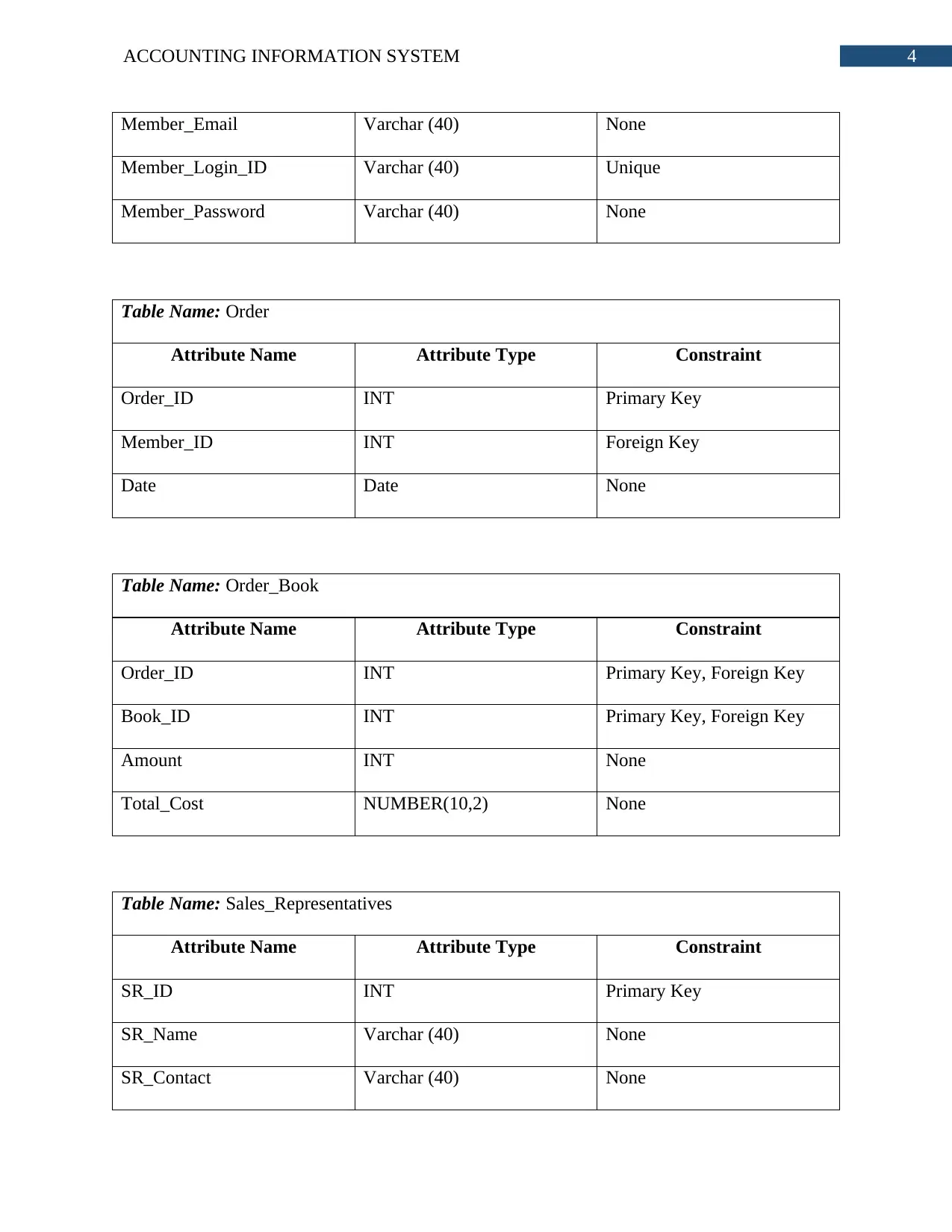
4ACCOUNTING INFORMATION SYSTEM
Member_Email Varchar (40) None
Member_Login_ID Varchar (40) Unique
Member_Password Varchar (40) None
Table Name: Order
Attribute Name Attribute Type Constraint
Order_ID INT Primary Key
Member_ID INT Foreign Key
Date Date None
Table Name: Order_Book
Attribute Name Attribute Type Constraint
Order_ID INT Primary Key, Foreign Key
Book_ID INT Primary Key, Foreign Key
Amount INT None
Total_Cost NUMBER(10,2) None
Table Name: Sales_Representatives
Attribute Name Attribute Type Constraint
SR_ID INT Primary Key
SR_Name Varchar (40) None
SR_Contact Varchar (40) None
Member_Email Varchar (40) None
Member_Login_ID Varchar (40) Unique
Member_Password Varchar (40) None
Table Name: Order
Attribute Name Attribute Type Constraint
Order_ID INT Primary Key
Member_ID INT Foreign Key
Date Date None
Table Name: Order_Book
Attribute Name Attribute Type Constraint
Order_ID INT Primary Key, Foreign Key
Book_ID INT Primary Key, Foreign Key
Amount INT None
Total_Cost NUMBER(10,2) None
Table Name: Sales_Representatives
Attribute Name Attribute Type Constraint
SR_ID INT Primary Key
SR_Name Varchar (40) None
SR_Contact Varchar (40) None
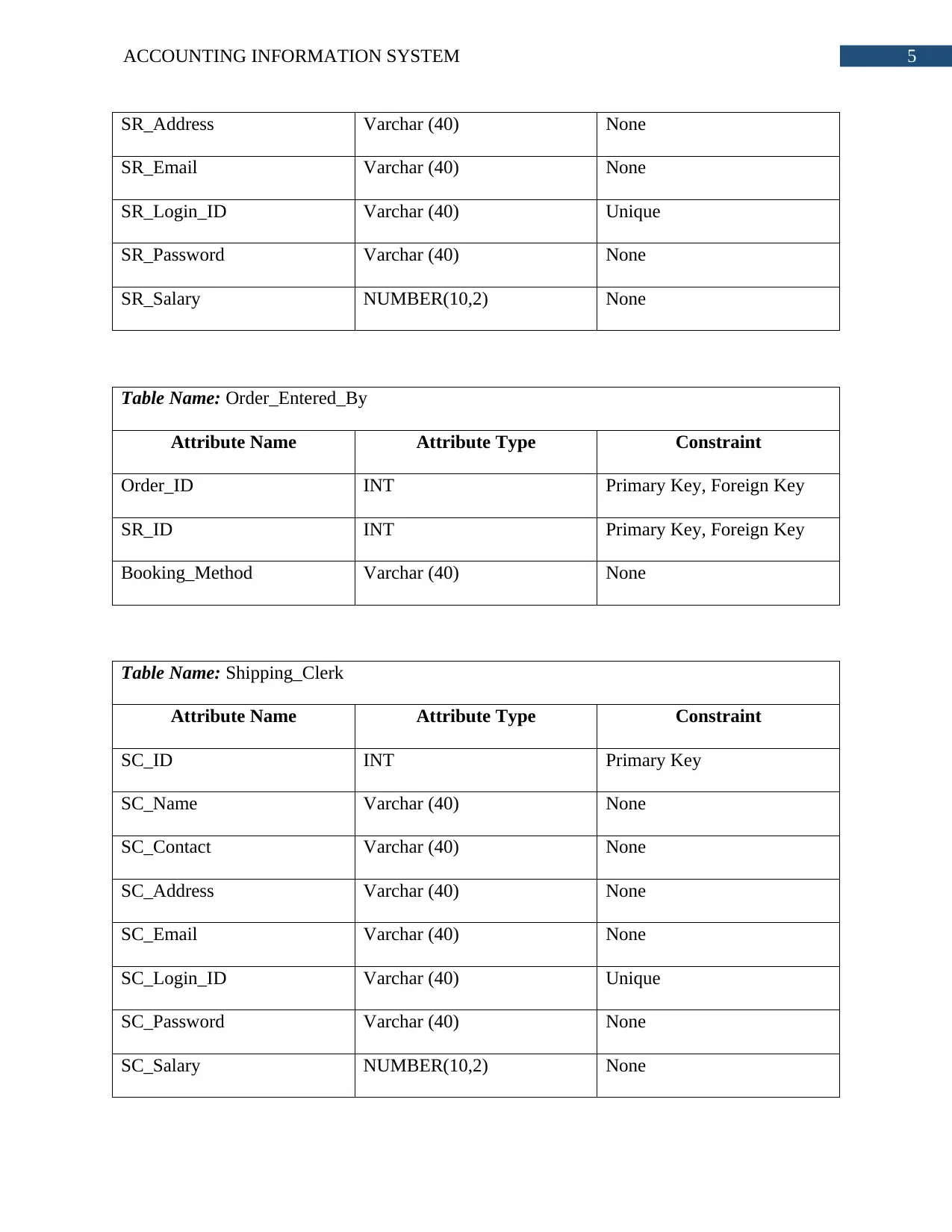
5ACCOUNTING INFORMATION SYSTEM
SR_Address Varchar (40) None
SR_Email Varchar (40) None
SR_Login_ID Varchar (40) Unique
SR_Password Varchar (40) None
SR_Salary NUMBER(10,2) None
Table Name: Order_Entered_By
Attribute Name Attribute Type Constraint
Order_ID INT Primary Key, Foreign Key
SR_ID INT Primary Key, Foreign Key
Booking_Method Varchar (40) None
Table Name: Shipping_Clerk
Attribute Name Attribute Type Constraint
SC_ID INT Primary Key
SC_Name Varchar (40) None
SC_Contact Varchar (40) None
SC_Address Varchar (40) None
SC_Email Varchar (40) None
SC_Login_ID Varchar (40) Unique
SC_Password Varchar (40) None
SC_Salary NUMBER(10,2) None
SR_Address Varchar (40) None
SR_Email Varchar (40) None
SR_Login_ID Varchar (40) Unique
SR_Password Varchar (40) None
SR_Salary NUMBER(10,2) None
Table Name: Order_Entered_By
Attribute Name Attribute Type Constraint
Order_ID INT Primary Key, Foreign Key
SR_ID INT Primary Key, Foreign Key
Booking_Method Varchar (40) None
Table Name: Shipping_Clerk
Attribute Name Attribute Type Constraint
SC_ID INT Primary Key
SC_Name Varchar (40) None
SC_Contact Varchar (40) None
SC_Address Varchar (40) None
SC_Email Varchar (40) None
SC_Login_ID Varchar (40) Unique
SC_Password Varchar (40) None
SC_Salary NUMBER(10,2) None
⊘ This is a preview!⊘
Do you want full access?
Subscribe today to unlock all pages.

Trusted by 1+ million students worldwide

6ACCOUNTING INFORMATION SYSTEM
Table Name: Order_Packed_By
Attribute Name Attribute Type Constraint
Order_ID INT Primary Key, Foreign Key
SC_ID INT Primary Key, Foreign Key
Complete Boolean None
Table Name: Invoice
Attribute Name Attribute Type Constraint
Invoice_ID INT Primary Key
Order_ID INT Foreign Key
Date Date None
Total_Cost NUMBER(10,2) None
Table Name: Payment
Attribute Name Attribute Type Constraint
Payment_ID INT Primary Key
Invoice_ID INT Foreign Key
Date Date None
Paid_Amount NUMBER(10,2) None
Table Name: Order_Packed_By
Attribute Name Attribute Type Constraint
Order_ID INT Primary Key, Foreign Key
SC_ID INT Primary Key, Foreign Key
Complete Boolean None
Table Name: Invoice
Attribute Name Attribute Type Constraint
Invoice_ID INT Primary Key
Order_ID INT Foreign Key
Date Date None
Total_Cost NUMBER(10,2) None
Table Name: Payment
Attribute Name Attribute Type Constraint
Payment_ID INT Primary Key
Invoice_ID INT Foreign Key
Date Date None
Paid_Amount NUMBER(10,2) None
Paraphrase This Document
Need a fresh take? Get an instant paraphrase of this document with our AI Paraphraser
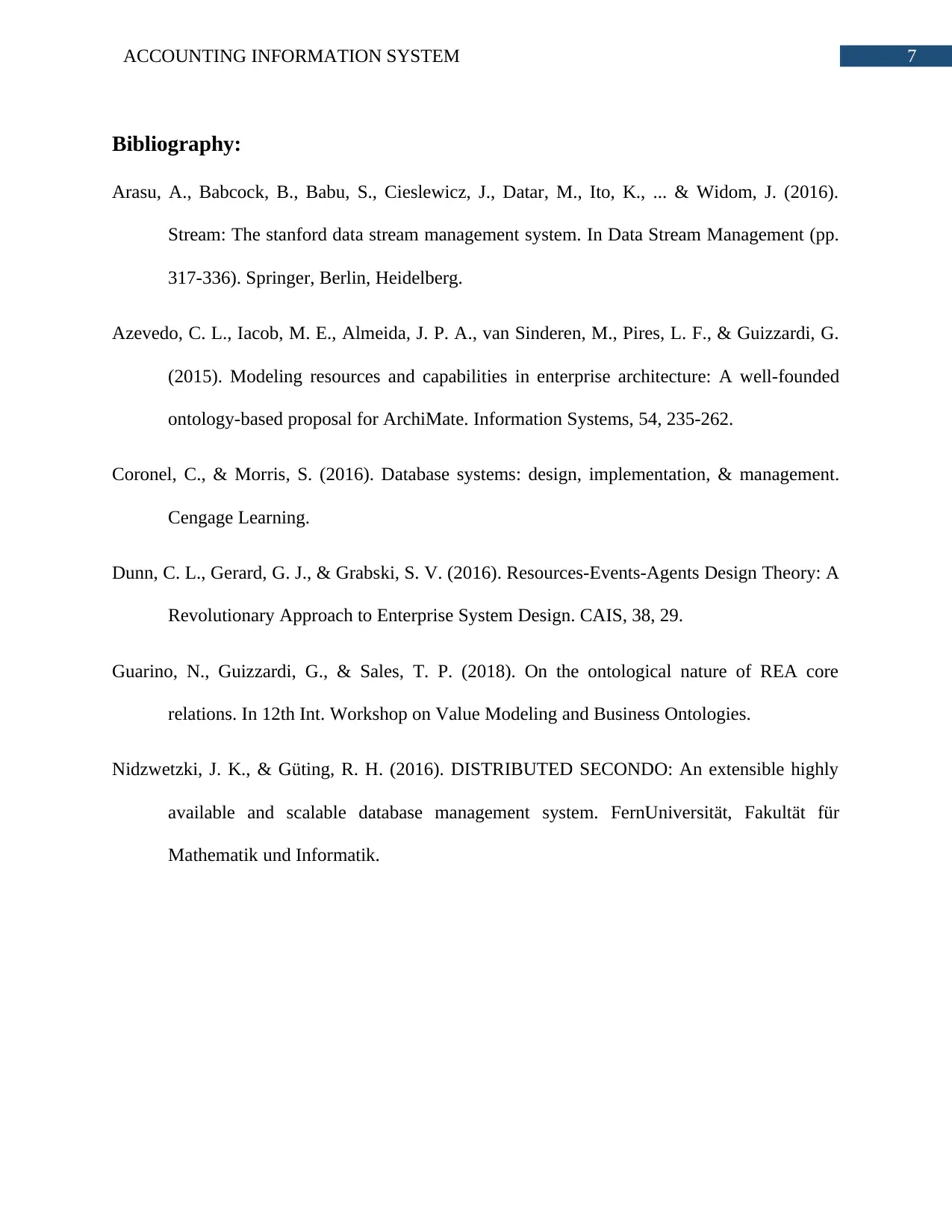
7ACCOUNTING INFORMATION SYSTEM
Bibliography:
Arasu, A., Babcock, B., Babu, S., Cieslewicz, J., Datar, M., Ito, K., ... & Widom, J. (2016).
Stream: The stanford data stream management system. In Data Stream Management (pp.
317-336). Springer, Berlin, Heidelberg.
Azevedo, C. L., Iacob, M. E., Almeida, J. P. A., van Sinderen, M., Pires, L. F., & Guizzardi, G.
(2015). Modeling resources and capabilities in enterprise architecture: A well-founded
ontology-based proposal for ArchiMate. Information Systems, 54, 235-262.
Coronel, C., & Morris, S. (2016). Database systems: design, implementation, & management.
Cengage Learning.
Dunn, C. L., Gerard, G. J., & Grabski, S. V. (2016). Resources-Events-Agents Design Theory: A
Revolutionary Approach to Enterprise System Design. CAIS, 38, 29.
Guarino, N., Guizzardi, G., & Sales, T. P. (2018). On the ontological nature of REA core
relations. In 12th Int. Workshop on Value Modeling and Business Ontologies.
Nidzwetzki, J. K., & Güting, R. H. (2016). DISTRIBUTED SECONDO: An extensible highly
available and scalable database management system. FernUniversität, Fakultät für
Mathematik und Informatik.
Bibliography:
Arasu, A., Babcock, B., Babu, S., Cieslewicz, J., Datar, M., Ito, K., ... & Widom, J. (2016).
Stream: The stanford data stream management system. In Data Stream Management (pp.
317-336). Springer, Berlin, Heidelberg.
Azevedo, C. L., Iacob, M. E., Almeida, J. P. A., van Sinderen, M., Pires, L. F., & Guizzardi, G.
(2015). Modeling resources and capabilities in enterprise architecture: A well-founded
ontology-based proposal for ArchiMate. Information Systems, 54, 235-262.
Coronel, C., & Morris, S. (2016). Database systems: design, implementation, & management.
Cengage Learning.
Dunn, C. L., Gerard, G. J., & Grabski, S. V. (2016). Resources-Events-Agents Design Theory: A
Revolutionary Approach to Enterprise System Design. CAIS, 38, 29.
Guarino, N., Guizzardi, G., & Sales, T. P. (2018). On the ontological nature of REA core
relations. In 12th Int. Workshop on Value Modeling and Business Ontologies.
Nidzwetzki, J. K., & Güting, R. H. (2016). DISTRIBUTED SECONDO: An extensible highly
available and scalable database management system. FernUniversität, Fakultät für
Mathematik und Informatik.
1 out of 8
Related Documents
Your All-in-One AI-Powered Toolkit for Academic Success.
+13062052269
info@desklib.com
Available 24*7 on WhatsApp / Email
![[object Object]](/_next/static/media/star-bottom.7253800d.svg)
Unlock your academic potential
Copyright © 2020–2025 A2Z Services. All Rights Reserved. Developed and managed by ZUCOL.





